With Laima Ardaviciene
November 2024
Jewish Cemetery
Holocaust Memorial Site
Josvainiai before leaving
With Laima Ardaviciene
November 2024
Jewish Cemetery
Holocaust Memorial Site
Josvainiai before leaving
With Laima Ardaviciene
November 2024


16 July 2023


With Laima Ardaviciene and Harry Gorfine






Harry & Laima doing maintenance













Update on opening of Lost Shetl: now in Summer 2024






















































































On the road to Krakes

Krakes Cemetery













Meeting with Robertas Dubinka – Education Director and Daiva Dubinkienė, teacher.



Discussing In My Pocket Project.

https://elirab.au/project-update/





















Back in Josvainiai for dinner





Brekkie at the Hotel Conti

On the road to Kedainiai




Arrival at Laima’s house in Kedainiai

The Old Town



Meeting Phil and Aldona at the Cucumber Festival















Back in the Old Town at the synagogue

















Walking in the Old Town




























At Laima’s Atzalynas School





















Back at the Festival



















At the Cemetery












Since a few of our Keidaners, who do not speak Hebrew, asked me to write this report, I’m writing it this time in English. I apologize in advance to my Hebrew readers.
This year, a number of Keidan descendants – both from Israel and the USA – intended to come to Lithuania for the 80th anniversary (August 28, 1941) of the mass slaughter of our families and the whole Jewish community of Kėdainiai. For most of them, because of the COVID-19 pandemic, this appeared to be too complicated. Nevertheless, the commemoration meeting by the mass grave in Daukšiai village is already a tradition in Kėdainiai, so it took place as usual in recent years. Like back in 1941, this year also, the day of August 28 fell on Saturday. For this reason, the commemoration meeting was moved to August 29.
The last time I was standing in this Valley of Slaughter[1], on this particular commemoration day, was August 29, 1971, exactly 50 years ago, a few months before leaving Lithuania to Israel. It was also Sunday – as our parents were coming to this place once a year, on the first Sunday following August 28 (in the Soviet Union you couldn’t take a day off on any other day). At that time, we were sure that if we ever manage to leave Lithuania, we will never come back to this place. But time passed, the world map and our minds have changed, and we came to Kėdainiai again.

Thanks to the efforts of Rimantas Žirgulis, a director of the Kėdainiai Regional Museum, who actually became our spokesman and representative versus Kėdainiai district municipality, and readiness of the municipality mayor, Valentinas Tamulis, to cooperate, a few changes were made at this mass murder site and the old Jewish cemetery of Kėdainiai:
Almost 50 people participated in the commemoration. Among them:
As the vast majority of participants were Lithuanians, the meeting was held – except for the prayers recited in Hebrew – in the Lithuanian language.
Because of this, I try to translate (not literally, but so as to preserve the essence of the talks) and present here a summary of things being said.
The commemoration meeting was opened at 15:00 by Rimantas Žirgulis. He told that Kėdainiai had seen many tragedies in its history, but this mass murder which happened here 80 years ago, was undoubtedly the most horrible, bloody and brutal event in its history – when a few dozens of Kėdainiai townsmen murdered from two to more than three thousands of Kėdainiai, Šėta and Žeimiai Jews only because they were Jews. „Those people, who lived in our town for more than three hundred years, who were our neighbors, who created this town with us, built it, traded in it, bought in the same shops, who were an integral part ofKėdainiai, Šėta, and Žeimiai communities and their economic life. Because of a crazy idea of some madmen that these people have no right to live, on one single day in the course of a few hours, a few dozen of our Lithuanian fellow citizens guided by several German Nazis drove all those people to this pit – 100 meters long, 3 meters wide and 2.5 meters deep.“
To honor the martyrs, Rimantas declared a few minutes of silence. We knew that at that moment, other Keidaners joined us in different parts of the world.
Flowers were put on the memorial and candles were lit.
Rimantas continued by telling that 10 years ago, on the 70th anniversary of this tragedy, when the memorial iron boards holding the names of the murdered, were erected here, a Jewish Keidan descendant, prof. Mira Sklarew from the USA participated in the commemoration. A singer Vilma Merkytė performed then „The Songs of Orphans“. Hearing the song, Rimantas felt, that Kėdainiai became orphaned after the war. “Fortunately, out of thousands murdered, a handful of Kėdainiai Jews survived the Holocaust. Therefore today we have a possibility to be with our guests, their descendants, who came from Israel and the USA[2]. Their visit and relations we keep with them are very important for us” – said Rimantas. “Despite all the horrible things that happened here – following which some people totally cut off their ties with Lithuania and Kėdainiai – they came to participate in this commemoration together with us. Moreover, the Israel Association of Keidan Jews brought a present – a new memorial plaque, funded by them and now installed on the memorial. This memorial was erected here by Kėdainiai Holocaust survivors in 1957. It was recently renewed by the Kėdainiai municipality and the whole place around the memorial was ordered and reorganized, looking today completely different, more decent and civilized than it looked for dozens of years, and I want to thank the municipality for this.”
On behalf of the Israel Association of Keidaners, I tried to talk in Lithuanian, which I didn’t use for the last 50 years. Because of this and because I didn’t want to repeat things that were already said, I changed my introduction, so the talk went stumbling, but it can be approximately summarized as follows. I told that I’m glad to see that so many people gathered here. “When I came to Lithuania for the first time, 15 years ago, I saw that nothing changed here from the time I left. Nobody took care of Jewish heritage, there were almost no signs that Jews ever lived in Kėdainiai. But about 10 years ago, I’ve discovered two new friends here – Rimantas and Laima, and today, looking at the people who gathered here, I see that we have many more friends in Kėdainiai. And this is exciting.”
“Each time, when this day approaches (and in recent years we commemorate it simultaneously in Israel and Lithuania), I recall the Hebrew saying of Passover: ‘On this day each of us must see himself as if he came out of Egypt, from slavery to freedom’. On such a day as this, on the contrary, I see myself standing among my family members and other Keidan Jews in this death pit, and with time this feeling becomes more painful. Sometimes people wonder – why to be occupied with these old memories, with those people who are dead for so many years, and nobody can help them today? Then I always recall a book, which I received as a present on my 10th birthday. The book was named ‘The Legend about Till Ulenspiegel and his Adventures’ [3]. It was written in an easy-going manner, as if for the children, and published in the children’s publishing house. But it talked also about hard things, and among others, about Till’s father, who was burnt at stake following a false denunciation by his neighbor. At night, Till sneaked to the execution place, picked up a handful of ashes of his father, and filled with it a small bag, which from that time he always carried on his chest, like a medallion. Whenever anybody started talking to him, Till’s first words were: ‘My father’s ashes are pounding on my heart’, irrelevant of the circumstances and the topic of the conversation. And this is exactly what I want to say here: ‘All these years the ashes of the murdered are pounding on my heart’, and I‘m unable to forget them.”
“I want to add that in all those years after the war, Jewish pain was totally denied by Soviet authorities. It wasdiscarded to such an extent, that the word ‘Jew’ wasn’t allowed to be written on memorials at the mass graves all over Lithuania and the Soviet Union. The same happened in Kėdainiai – ‘To the Victims of Fascist Terror’ was written there for many years. Only by the end of the 70s, a new inscription appeared, saying that Jews were murdered here.”
“Two things are important to us: acknowledgment of the Jewish suffering and pain, and preservation of Jewish memory in Kėdainiai.
Coming in recent years to Kėdainiai, I see more signs of the former Jewish presence in the city, and I want to thank all Kėdainiai people who are responsible for this. First of all – Rimantas Žirgulis from the Kėdainiai Regional Museum, then – Valentinas Tamulis, the Kėdainiai district mayor, Audrone Pečiulytė from theKėdainiai Regional Museum and Laima Ardavičienė from the Kėdainiai Atžalynas gymnasium for their most important educational activity – so that the young Kėdainiai generation knew that other people also lived once in this town, that they were innocently murdered, and that such atrocities should never happen again in the future.“
Finally, according to the old Jewish tradition, I recited psalms and El Male Rachamim to those lying in the common grave.
The vice mayor of Kėdainai, Paulius Aukštikalnis, greeted all those who came for the commemoration. He told that it is very difficult to talk on such occasions, to find proper words for such tragedy. “This is mainly done by historians. The birch tree by the memorial with an iron rod of the fence passing through its trunk symbolizes brothers and sisters who fell into this pit when lead bullets pierced their hearts. Such tragedy is like a severe burn for a human being. We must always remember this. The second tragedy would be to forget such events. So, we must thank people like Rimantas, Audrone, and other members of this community who do not allow us to forget, who each year remind us of what had happened here, and who organize such commemorations. We will not have proper knowledge of how to create a future without remembering the painful events that burnt us. Forgetting history can lead us to great errors. Although 80 years passed and the blood is soaked deep in this ground, remembering this event is very important to all of us. Politicians should be brought to such places and shown that such things should not happen. Such gatherings and sincere discussions will only strengthen us as a society and allow us to proceed further into the future. You, Rimantas, don’t have to thank the municipality for upgrading this place, but we must thank you for telling us what should be done – so that the history will not disappear. I wish all of us to leave this place remembering what had happened here and reminding the young generation what shouldn’t be done. Only in this way, we will not destroy ourselves.”
Rafailas Karpis concluded the meeting with a breathtaking performance of Kaddish.

An hour later, being accompanied by Darius Mažintas (piano), he gave a beautiful concert of Yiddish songs in the Town Hall of Kėdainiai. This was one of the best performances of Yiddish songs (in clear Lithuanian Yiddish) I ever heard.
To get an impression of the event, here’s a link to a set of photographs:
https://photos.app.goo.gl/hdc44o9gh5eTjSLE9
The following report was broadcast the same day during the evening news on Balticum TV – the cable channel covering the whole Kėdainiai district:
https://www.youtube.com/watch?v=q_fXYM0RtWI
It includes excerpts of short interviews, given separately by Rimantas and me before the event. Although, for those who do not speak Lithuanian, there is a problem…
As a continuation of this memorable day, on September 17, 2021, another event took place in Kėdainiai: “The Road of the Memory 1941-2021”. It was a part of the similar commemoration events in several other small and large towns of Lithuania – marking the beginning of the Holocaust in Lithuania in 1941, when almost the whole Lithuanian Jewish population was brutally annihilated in the course of a few summer and autumn months.
It included a memory march, starting in the park (the former estate, where Jews were kept for almost two weeks before their bitter end) and walking to the slaughter place at Daukšiai village, where the commemoration meeting took place.
In addition to our Kėdainiai friends, who already participated in the commemoration of August 29, Tomas Bičiūnas a member of the Lithuanian parliament from Kėdainiai, Ronaldas Račinskas, from Vilnius, a chairman of the international commission for evaluation of crimes of the Nazi and Soviet occupation regimes in Lithuania, Gercas Žakas, a chairman of the Kaunas Jewish community, and several new other people joined the march. Children from the six Kėdainiai schools (one class from each school) were invited as well. The weather was cold and very windy. It was raining the night before, so part of the road was muddy and slippery. Still nobody complaint. Somebody said: “our inconvenience because of the weather is nothing compared to what suffered Jews walking their last road”. One of the large posters had the following text: “We love the Jewish people. We are in pain because of the Holocaust”.
The commemoration meeting took place by the mass grave. Borisas Kiržneris played violin. Israel ambassador to Lithuania, Yossi Levy, and a cultural attaché of the Federal Republic of Germany, Anja Luther, came from Vilnius to take part in the event:
https://photos.app.goo.gl/xoudCe3ZQRxuruvv5
————————————————————-
A few days ago we received a new present from Laima Ardavičienė and her students.
In recent years, the Lithuanian Radio and Television (LRT) authority created a series of documentaries about Lithuanian towns and shtetls and their lost Jewish communities.
The layout of all these documentaries is similar – two young people are walking around the town, discussing various aspects of its Jewish history.
One of these documentaries was about Kėdainiai. Unfortunately, there were no English subtitles. In the last months, Laima and her students worked hard to dub this documentary into English. Here you have a result of their work:
https://www.youtube.com/watch?v=Hv0X25bOJ4Y
[1] Jeremiah 7:32
[2] In fact, a few descendants from Lithuania participated in the meeting as well, but we didn’t know that at that moment.
[3] More precisely: “The Legend about Till Ulespiegel and Lamme Goedzak and their Adventures Heroical, Joyous and Glorious in the Land of Flanders and Elsewhere” was authored by a Flemish writer, Charles de Coster in 1867. Published in Russian in 1956, the book described the Flemish struggle against Spanish oppressors in the 16th century. The atmosphere in the country (Holland) strikingly resembled the one in the Soviet Union under the iron fist of the KGB. It’s a miracle that the book was published there at that time.

KehilaLink:
https://kehilalinks.jewishgen.org/kedainiai

By Aryeh Leonard Shcherbakov


Today, on Hoshana Raba in 1811, my 3rd great grandfather, Avraham Shlomo Zalman Zoref arrived in Israel from Keidan in Lithuania. Zoref, a student of the Vilna Gaon, was the leader of the pioneers …
Source: elirab.me/203-years-ago-today-zalman-tzoref-arrived-in-israel/

This video is about Avraham Shlomo Zalman Tzoref. It is a trailer for the full length documentary film made by Orna Bird and Omri Lior!
Source: youtu.be/_oRwIM796A0


Atzalynas Gimnazija, Kedainiai Lithuania
Reflecting back to June 2019
Rabbi Dan Fink
Bobbie Lamont
Eli Rabinowitz
13 June 2019
VIDEO OF OUR EVENT IN LITHUANIA

For video, click here:
Source: www.youtube.com/watch?v=pZXBEuPfeFc


At the school
At the cemetery
At the Holocaust site
Vale Simonas Dovidavicius.
Standing between Laima Ardaviciene and me in Kėdainiai, Lithuania on 15 June this year. Simon passed away last week and was laid to rest on the 18th December 2019.



My third great grandfather, Avraham Shlomo Zalman Zoref, was the first official victim of terror in the modern era, recognised by the State of Israel – see below.

Rabbi Avraham Shlomo Zalman Tzoref was killed trying to rebuild the Hurva Synagogue in 1851.
Source: www.haaretz.com/1.4977625
Rabbi Avraham Shlomo Zalman Zoref also known as Ibrahim Salomon (1786-1851), born in Kėdainiai, was one of the first pioneers who rebuilt the Ashkenazi Jewish community in Jerusalem in the beginning of the 19th century.
After making Aliyah and arriving in Ottoman Jerusalem, in 1824 the rabbi was sent to Constantinople by the head of the Perushim of Jerusalem, and succeeded in procuring a royal firman, commanding the kadi of Jerusalem to enforce the declaration of debt annualization concerning the Ashkenazi Jewish community of Jerusalem.[1]
With the annexation of Jerusalem by Muhammad Ali of Egypt in 1831, a window of opportunity arose for the Perushim. On 23 June 1836, after traveling to Egypt, rabbi Zoref, together with the backing of the Austrian and Russian consuls in Alexandria, obtained the long-awaited firman for the reconstruction of the Hurva Synagogue.
Zoref became deeply engaged with Jewish lands seized by the creditors in Jerusalem and appeased the Arabs with annual bribes, but at some point the arrangement ceased and they tried to kill him. One night he was shot at by an unknown assailant who missed but later drowned after falling into a cistern. On a second occasion he was attacked on his way to prayers early one morning. In 1851, Zoref was struck on the head with a sword and died of his wounds three months later.[2]
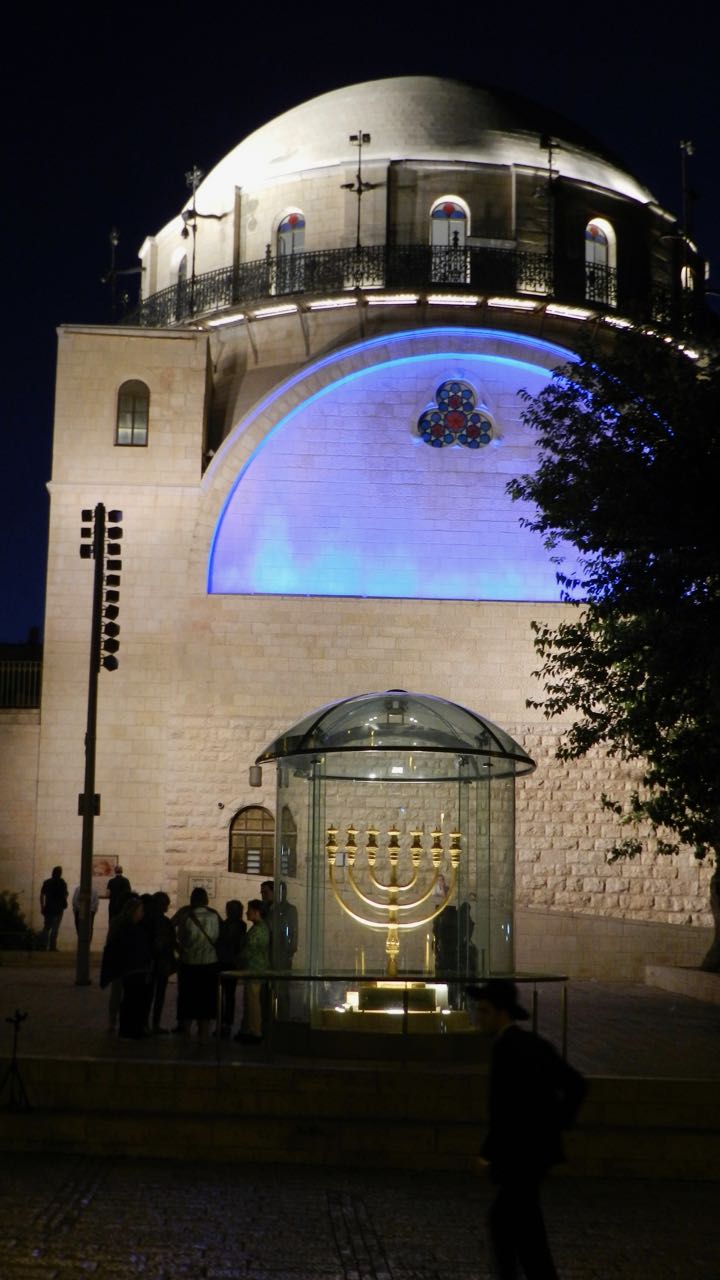

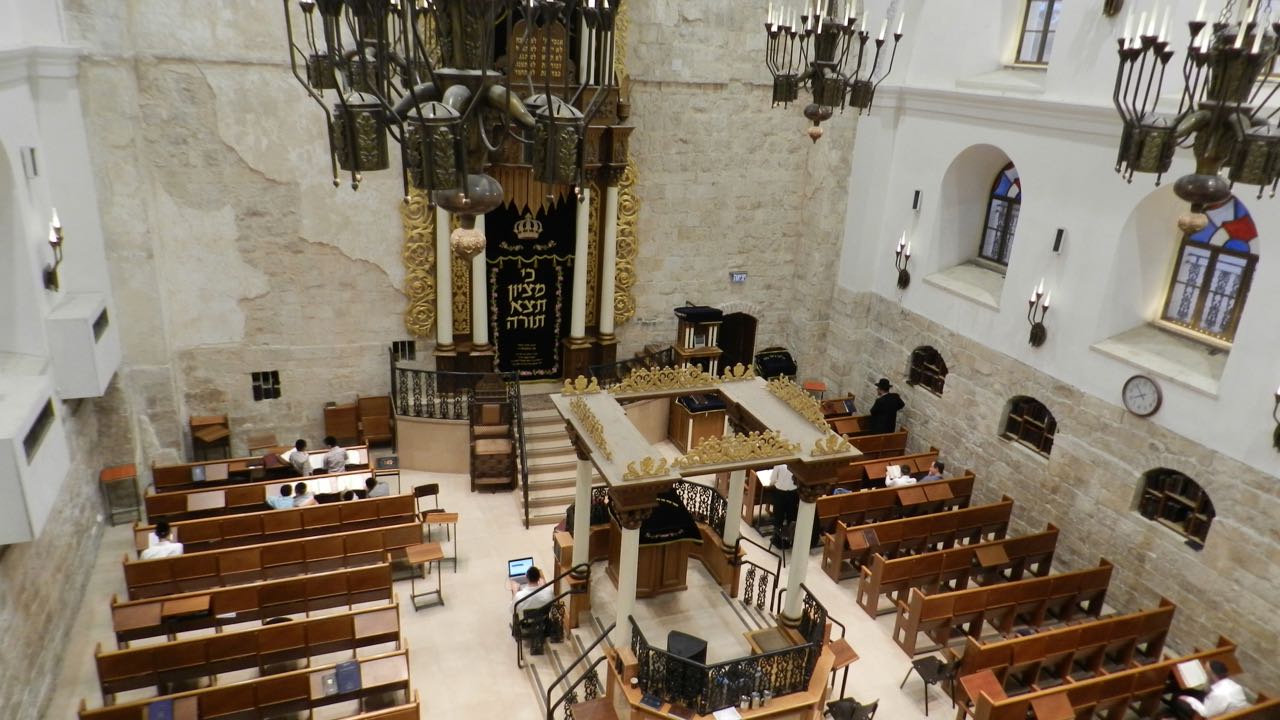

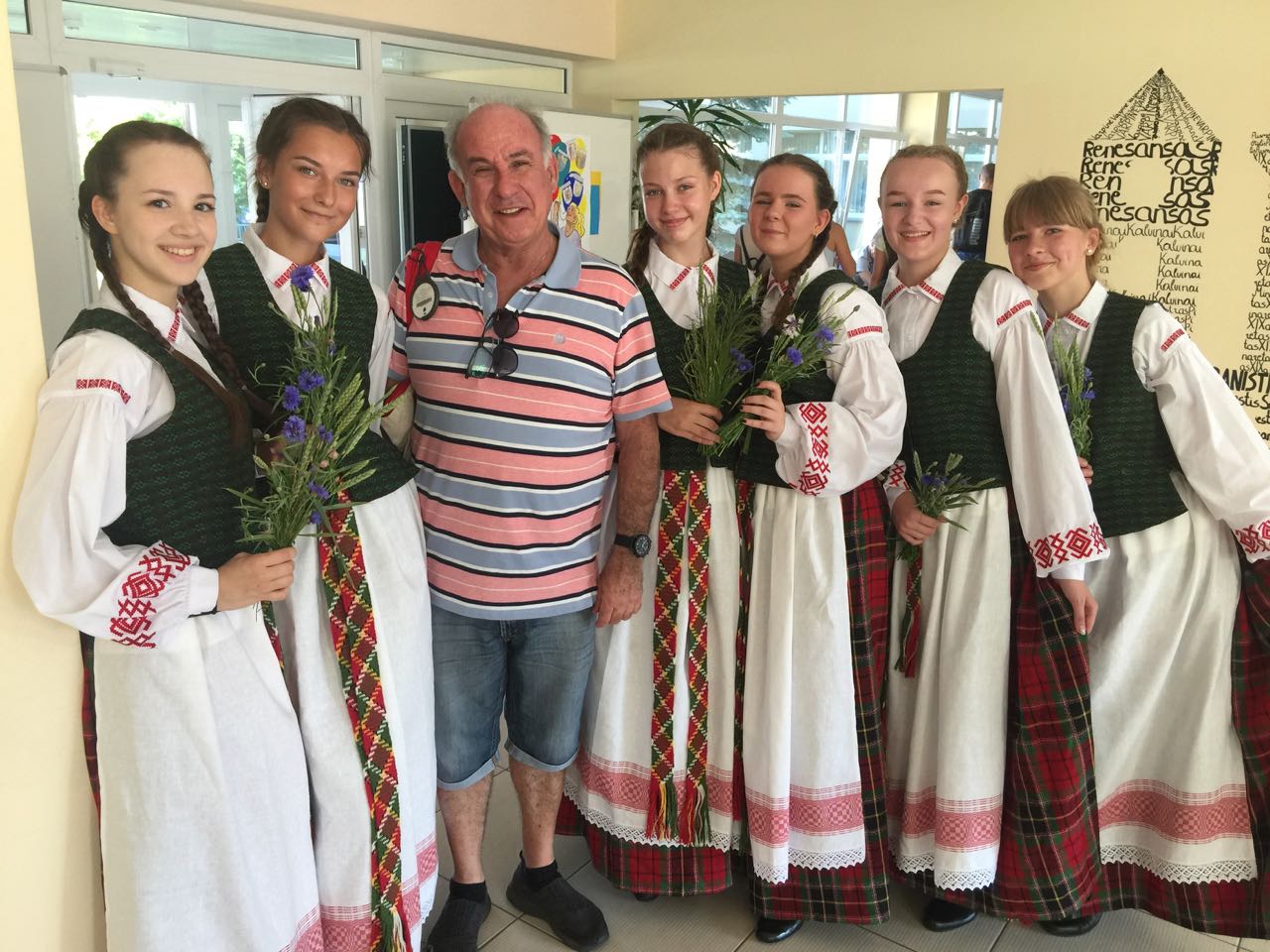
Atzalynas Gimnazija, Kedainiai Lithuania
13 June 2019
VIDEO OF OUR EVENT IN LITHUANIA

For video, click here:
Source: www.youtube.com/watch?v=pZXBEuPfeFc
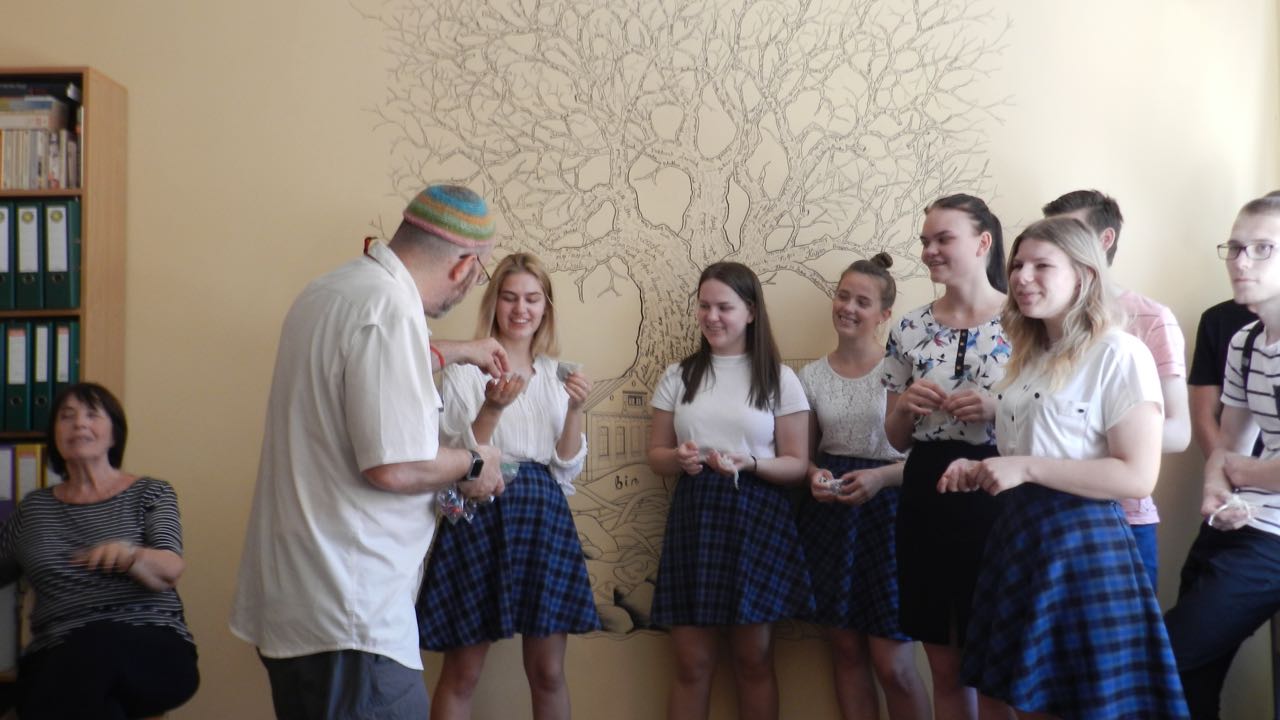
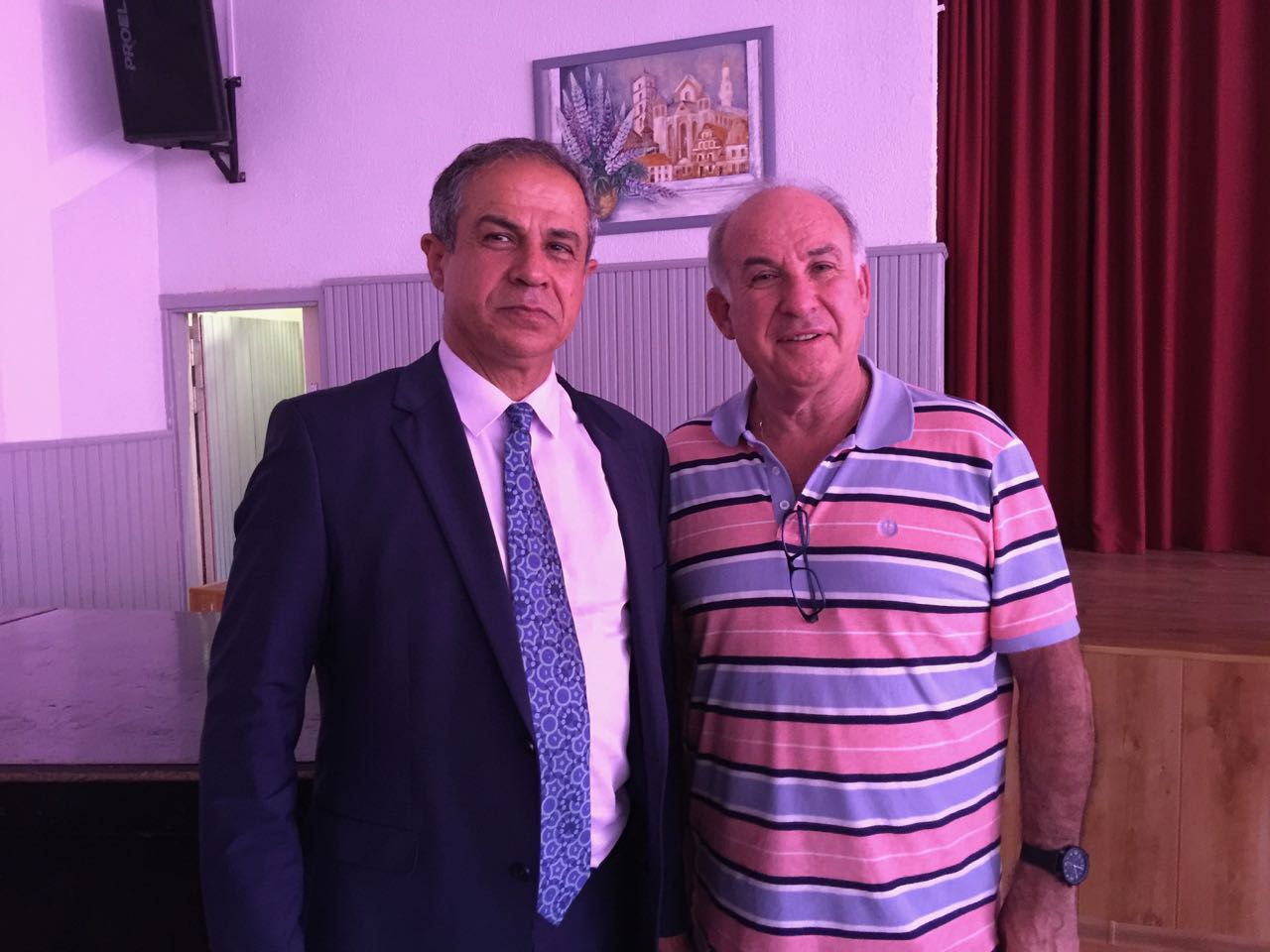
At the school
At the cemetery
At the Holocaust site
In August of this year, an article appeared on the website of the Lithuanian municipality of Kėdainiai, under the headline: “With a minute of silence, Kėdainiai met Tel Aviv.” The text described an annual event, begun only a few years ago, commemorating the extermination of Kedainiai’s Jewish community on August 28, 1941, during the Nazi occupation of Lithuania.
At precisely 18:30, local leaders and others observed a minute of silence – while at that same moment, in Israel, descendants of that vanished Jewish community, who called their home Keidan, were doing the same thing.
Two simultaneous ceremonies – one at the hall of the association of the Vilna Jews in Tel Aviv, the other by the mass grave where more than 2,000 Keidan Jews were murdered 77 years earlier.
Such commemorations are a longstanding tradition in Israel, home to thousands of Jews who trace their families to Lithuania. But in Lithuania itself this is relatively new, and still uncommon, tradition. Kėdainiai’s annual observance began several years ago, and has grown each year. This year it was led by Saulius Grinkevičius, mayor of the municipality, and Rimantas Žirgulis, director of the regional museum. The participants included two mayor’s deputies, the heads of local cultural and educational institutions, members of the administration and museum workers, school teachers and other Kėdainiai citizens. A local television station broadcast the ceremony.
The event reflects an important recent change in public consciousness and attitude. To a significant degree, Lithuanians are confronting their country’s painful past. This is reflected in the media, in increased research into local Jewish history and culture, and in the restoration of sites related to Lithuania’s former Jewish communities. In Kėdainiai, the regional museum and its director have played an important role, as have teachers such as Laima Ardavičieneof the Kėdainiai Atžalynas gymnasium, or secondary school. As it was often in the past, Kėdainiai is providing leadership and serving as a role model for other communities in Lithuania.
Supporting those efforts going forward is a recently published English translation of the Keidan yizkor book – a volume of memoirs, historical accounts and other material gathered from survivors and descendants of the Jewish community after World War II. Originally published mostly in Hebrew and Yiddish in 1977, the book offers a multi-faceted view of Jewish life in Keidan – its history, its religious, educational, social and cultural institutions, youth organizations, portraits of its prominent people, recollections of witnesses and survivors before, during and after the Holocaust.
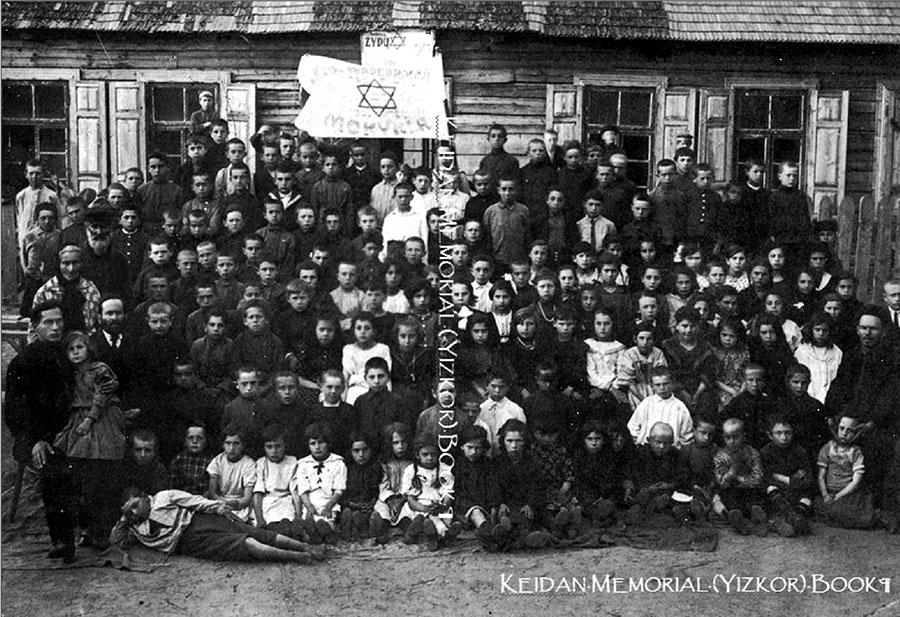
Cover of the Keidan Memorial (Yizkor) Book, recently translated into English. Edited by Aryeh Leonard Shcherbakov aryeh.shcherbakov@gmail.comand Andrew Cassel awcassel@gmail.com of the Keidan Associations of Israel and the U.S.; published by David Solly Sandler sedsand@iinet.net.auin Perth, Australia. The book is obtainable from any of the three above mentioned
Photos of Commemoration in Kedainiai – 28 August 2018

A section of the memorial erected in 2011 at the site of the Jews’ massacre near Kedainiai. Names of the victims were recorded as cutouts in the metal sheet.
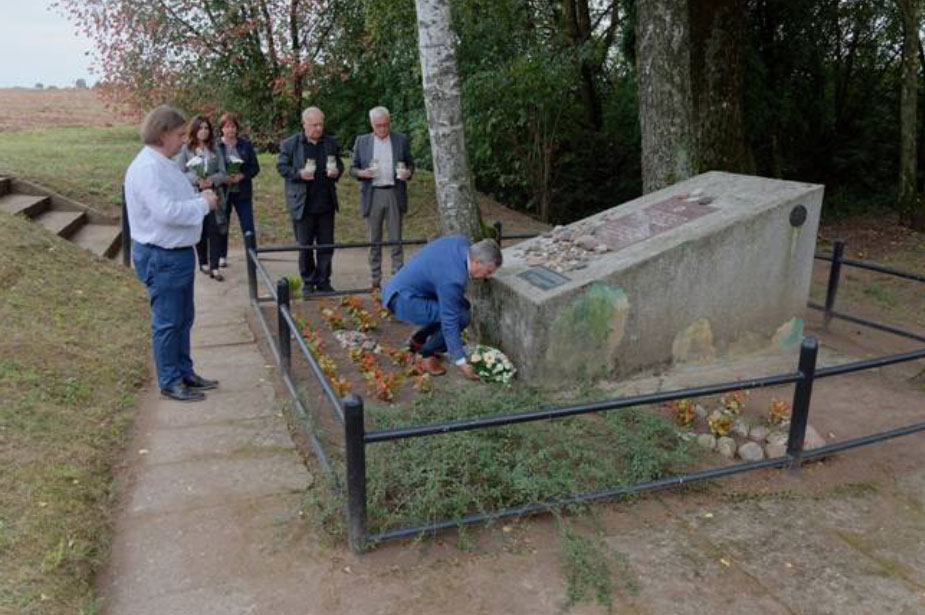
At the site of the 28 August 1941 massacre of Kedainiai’s Jews. Mayor Saulius Grinkevičius lays flowers, while Rimantas Žirgulis (in white shirt) observes.
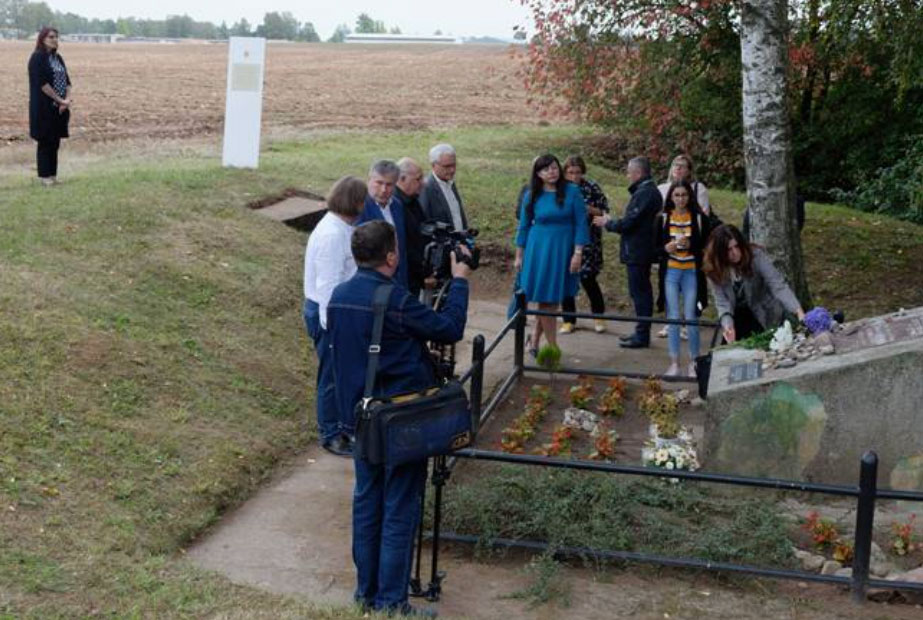
Local students and media participated in the commemoration.
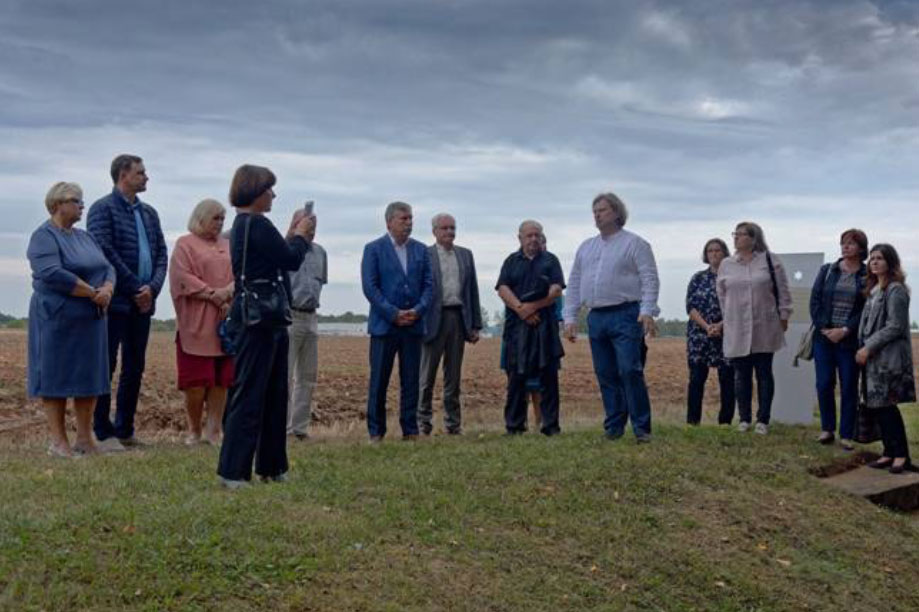
Laima Ardavičiene, a teacher at the Kėdainiai Atžalynas gymnasium, records the event.
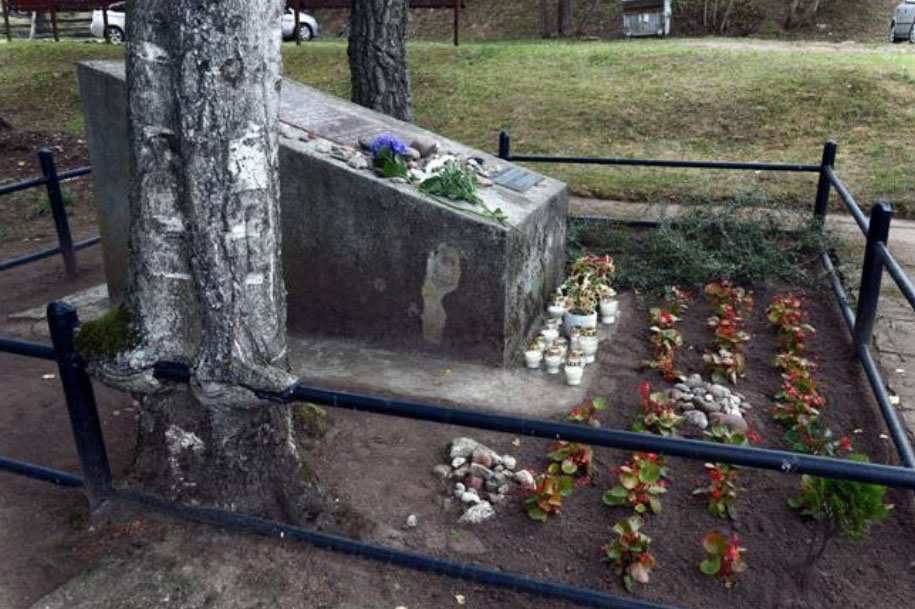
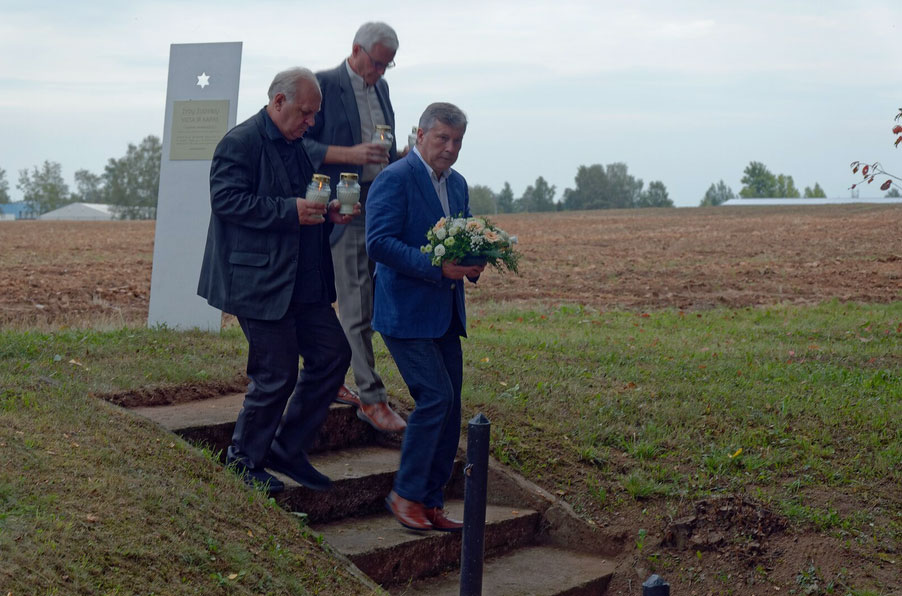
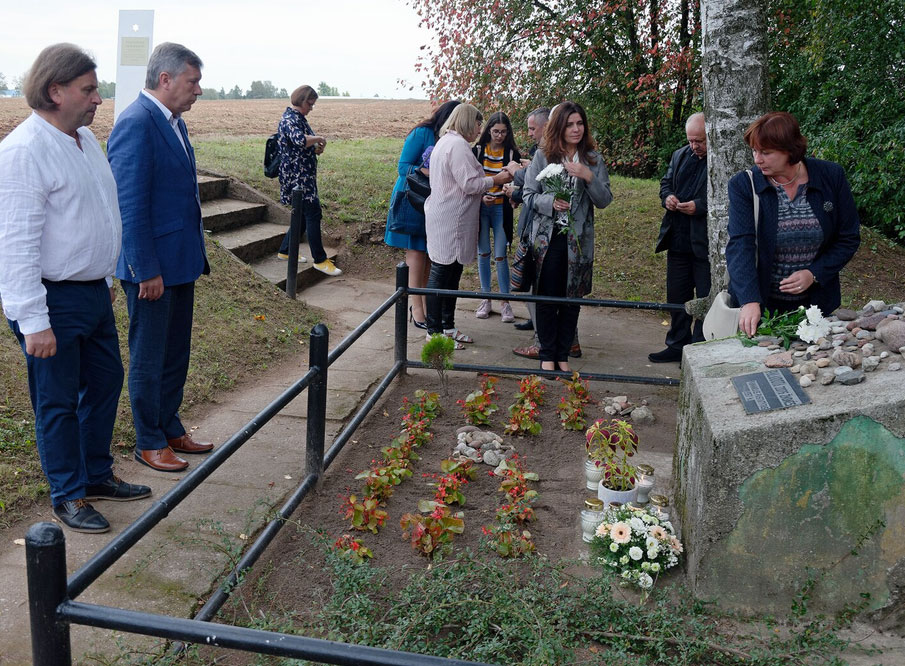
Article and photos by :Aryeh Leonard Shcherbakov aryeh.shcherbakov@gmail.com and Andrew Cassel awcassel@gmail.com of the Keidan Associations of Israel and the U.S and David Solly Sandler sedsand@iinet.net.au of Perth, Australia.
Source: kehilalinks.jewishgen.org/Johannesburg/Solly.html